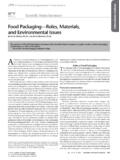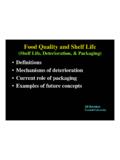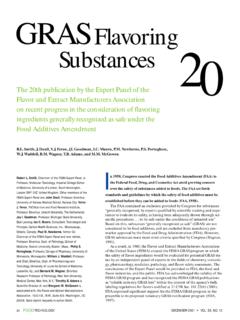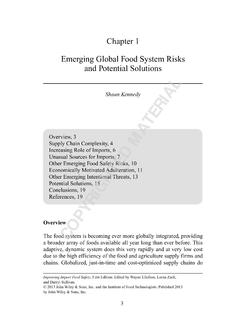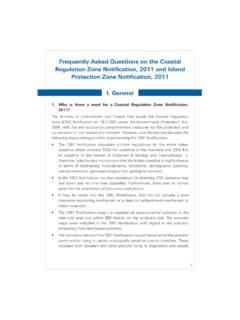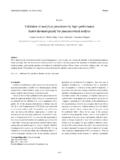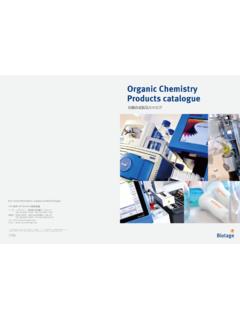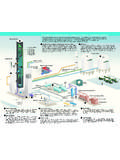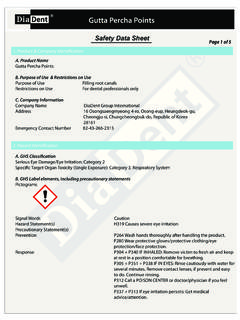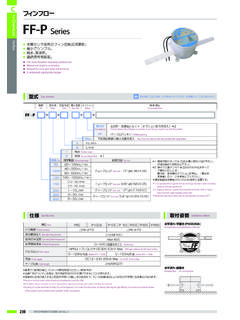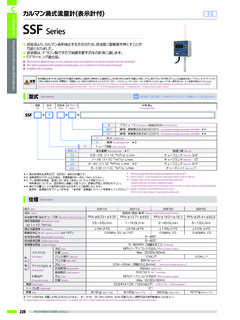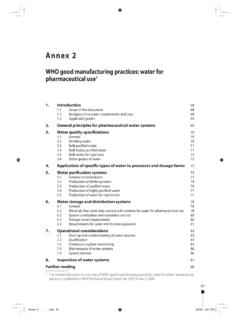Transcription of Advances in Dairy Ingredients - IFT.org
1 Advances in Dairy IngredientsCOPYRIGHTED MATERIAL INTRODUCTION The purpose of the dehydration of milk and whey is to stabilize these products for their storage and later use. Dehydration by spray drying is a valuable technique for water evapo-ration. Milk and whey powders are used mostly in animal feeds. With changes in agricul-tural policies (such as the implementation of the quota system and the dissolution of the price support system in the European Union), the Dairy industry has been forced to look for better uses for the Dairy surplus and for the by - products of cheese (whey) produced from milk and buttermilk produced from cream.
2 Studies on the use of protein fractions with nutritional qualities and functionality led us to believe that they could have several applications (Corredig, 2009 ; Thompson et al., 2009 ). In the past 30 years, the Dairy industry has developed new technological processes for extracting and purifying proteins ( , casein, caseinates, and whey proteins) (Kjaergaard et al., 1987 ; Maubois, 1991 ), such as milk protein concentrate ( MPC ), milk protein isolate ( MPI ), whey protein concentrate ( WPC ), whey protein isolate ( WPI ) (Goud dranche et al., 1980 ; Madsen and Bjerre, 1981 ; Maubois et al., 1987 ; Caron et al.)
3 , 1997 ), micellar casein concentrates ( MCC ) and isolates (MCI) (Fauquant et al., 1988 ; Pierre et al., 1992 ; Schuck et al., 1994a,b ) whey concentrates, and selectively demineralized whey concentrates (Jeantet et al., 1996 ), mainly because of the emergence of fi ltration technology ( , micro-fi ltration [MF], ultrafi ltration, nanofi ltration, and reverse osmosis). This recent emergence of new membrane separation techniques and improvements in chromatographic resins now provide the Dairy technologist with several types of techniques for the extraction and puri-fi cation of almost all of the main milk proteins. The most frequently used technique for the dehydration of Dairy products is spray drying.
4 It became popular in the Dairy industry in the 1970s, but at that time, there were few scientifi c or technical studies on spray drying, and, in particular, none on the effects of spray drying parameters or on the effects of the physicochemical composition and microbiology of the concentrates on powder quality. Manufacturers acquired expertise in milk drying and eventually in whey drying processes through trial and error. Because of the variety and complexity of the mixes to be dried, more rigorous method based on physi-cochemical and thermodynamic properties have become necessary. Greater understanding 1 Dairy Protein Powders P.
5 Schuck Advances in Dairy Ingredients , First Edition. Geoffrey W. Smithers and Mary Ann Augustin. 2013 John Wiley & Sons, Inc. and the Institute of Food Technologists. Published 2013 by John Wiley & Sons, Advances in Dairy Ingredientsof the biochemical properties of milk products before drying, water transfer during spray drying, the properties of powders, and infl uencing factors is now essential for the produc-tion of milk powder. The lack of technical and economic information and understanding of scientifi c methods prevents the manufacturer from optimizing his plant in terms of energy costs and powder quality.
6 In view of the increasing development of fi ltration pro-cesses, the Dairy industry requires greater understanding of the effects of spray drying on the quality of Dairy protein powders. A Dairy powder is characterized not only by its composition (proteins, carbohydrates, fats, minerals, and water), but also by its microbiological and physical properties (bulk and particle density, instant characteristics, fl owability, fl oodability, hygroscopicity, degree of caking, whey protein nitrogen index (WPNI), thermostability, insolubility index (ISI), dispersibility index, wettability index, sinkability index, free fat, occluded air, interstitial air, and particle size), which form the basic elements of quality specifi cations.
7 There are well - defi ned test methods for the determination of powder characteristics according to international standards (Pisecky, 1986 , 1990 , 1997 ; American Dairy Products Institute, 1990 ; Master, 2002 ). These characteristics depend on drying parameters ( , type of tower spray drier, nozzles/wheels, pressure, agglomeration and thermodynamic conditions of the air, such as temperature, relative humidity, and velocity), the composition and physico-chemical characteristics of the concentrate before spraying ( , viscosity, thermo - sensitivity and availability of water), and storage conditions. Several scientifi c papers have been pub-lished on the effects of technological parameters on these properties (Baldwin et al.)
8 , 1980 ; Pisecky, 1980 , 1981 , 1986 ; De Vilder, 1986 ; Tuohy, 1989 ; Jeantet et al., 2008a ; Master, 2002 ) (see Figure ). Water content, water dynamics and water availability are among the most important properties for all these powder properties and powder characteristics. The nutritional quality of Dairy powders depends on the intensity of the thermal process-ing during the technological process. Thermal processing induces physicochemical changes that tend to decrease the availability of nutrients ( , loss of vitamins, reduction of avail-able lysine content, and whey protein denaturation) or to produce nutritional compounds, such as lactulose (Straatsma et al.
9 , 1999a,b ). The aim of this chapter is to provide information on the extraction of milk proteins; the principles of spray drying, including equipment and energy consumption; the drying of high protein products, including the relationships between process and product; and the physical, functional, and biochemical properties of the powders. Following an in - depth introduction on Dairy protein products, this chapter covers four major areas: the extraction of milk proteins, the principles of spray drying (equipment and energy consumption), the drying of Dairy protein products and the properties of these powders. Figure Properties and qualities of powders.
10 PowderQualityDryingconditionsStoragecond itions BiochemicalpropertiesPhysicalpropertiesM icrobiologicalpropertiesConcentrateprope rties Dairy Protein Powders 5 EXTRACTION OF MILK PROTEINS Milk p roteins It would be impossible to develop the extraction of milk proteins without prior thorough knowledge of their biochemical and physicochemical properties. A brief description of the milk protein system is therefore important for understanding the principles used before discussing the recent developments in extraction procedures (Maubois and Ollivier, 1997 ). Bovine milk contains several that are classically divided into two major groups, that is, caseins, proteins which are insoluble at pH and 20 C, and whey proteins which remain in solution at pH The protein content of normal milk is expressed as N Milk contains 30 35 g protein/L.

